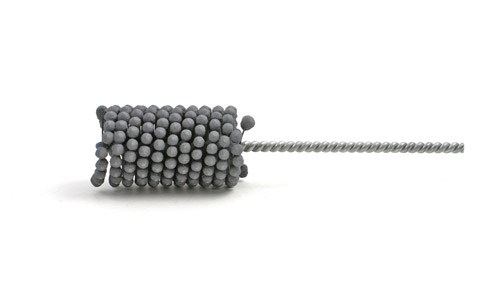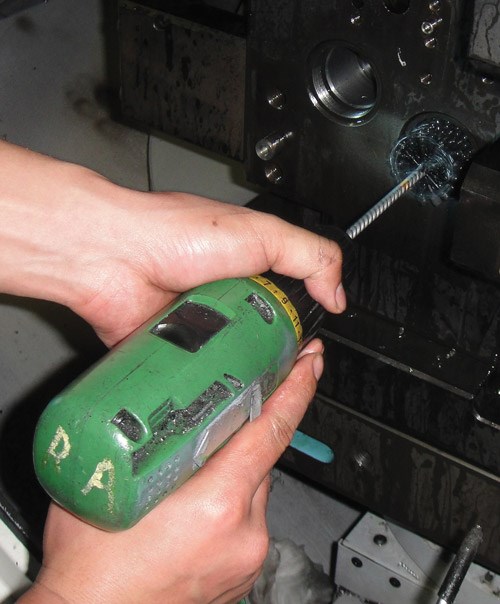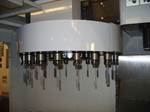Not much metal finishing equipment that is used in factory production setups is also readily available and applicable to situations where precision secondary finishing is also required in the field. Yet there are many instances when deburring, edge blending, cross hatching or other forms of honing surface finishes are required for installation or even emergency repair services.
When Vektek Inc. (Emporia, Kan.), a global supplier of hydraulic and pneumatic clamping systems for the metalworking, tool and die, and mold industries, sells cylinder products, the customer must ensure that the device into which the cylinder is installed has a properly finished cylinder cavity, or it will not seal and function properly.
“One of our customers, a major heavy equipment manufacturer in China, had a problem with its fixture cavities that caused our cylinders to not seal properly. These fixtures were produced for making mass produced parts,” says Rod Nelson, V.P. of Vektek International Sales. “The trouble was that the customer’s cavities were not machined suitably for installation. A flaw in its finishing process was missed.”
As a result, it appeared that the Vektek seals were leaking, a problem that was not a shortcoming in the cylinder design or quality, but nevertheless had to be solved at the customer’s site or these expensive fixtures would not be useable.
“There are two holes that are perpendicular to the cylinder cavity wall,” says Gordon King, general manager of Vektek’s Shanghai office. “Oil flows through these holes to different sides of the cylinder, but it must never leak past the body seals between them. The oil flows at high pressure (approximately 3,000 psi) through the lower hole to extend the cylinder. To return the cylinder, the oil flows into the hole toward the outside of the cavity. Because the required hole size and roundness are within 0.0005 inch, and the required surface finish is better than 32 roughness, imperfections such as minute scratches will create oil leaks if the holes aren’t finished correctly prior to cylinder installation.”Mr. King adds that the consequence of a leaking
cylinder could be very serious, since these Vektek devices hold workpieces’ stationary on machining fixtures. If the oil pressure in the cylinders drops because of leakage, the grip on the workpieces would fail, requiring the machine to be shut down and production to halt.
“Because many times the customer’s milling processes won’t give them a good enough finish, we recommend that they use a Flex-Hone tool (from
Brush Research Manufacturing Co.) to improve that finish as part of the cylinder installation process,” Mr. Nelson says.
Mr. King explains that finishing with a Flex-Hone gives the cylinder cavities a super high finish that is virtually unattainable through the use of standard cutting tools such as reamers or drills.
A Flex-Hone is a flexible, ball-style hone for surface finishing, deburring and edge blending of products including hydraulic cylinders, where tight tolerances and smooth surface finishes are essential for sealing purposes.
Vektek advised technicians at the manufacturing plant in China on using the flexible hone to properly surface finish the cylinder cavities so that the sealing problem would be eliminated.
“They were leaking because the inside of the cavities were too rough,” Mr. Nelson says. “In all, 300 cavities were flex honed, and 299 of the 300 cavities were saved and polished exactly to specification. One cavity was slightly out of spec, but it also provided an adequate seal. In the end, we saved 300 very expensive holes.”
Mr. Nelson says the flexible hone is so useful to his customers in properly preparing cavities for his company’s products that Vektek has for many years specifically recommended the tool in its product catalog and data sheets.
For this particular operation, the Flex-Hone was mounted on a standard drill motor. Mr. King says because this tool can be used in such portable equipment, it makes it all the more useful for highly polished field finishing operations.
“These cylinders require a very good seal, very accurate, very round, and with a high quality finish,” he says. “Because the flexible hone is self-centering, it is easy to get a uniform hole finish because it is always exerting the same sort of pressure on all sides. This is a true finishing operation.”
This tool can be used in any rotating spindle, ranging from the machining centers of high-volume production environments to a hand drill motor for secondary finishing, custom field finishing or even DIY applications.
In the case of Vektek cylinders, Mr. Nelson says the Flex-Hone is recommended for use on a range of cartridge mount cavity sizes installed in customer-specified materials. Therefore, the company does not recommend hone sizes or specifications.
“Manifold mount cylinder models have a required cavity finishing operation,” he says. “They range in size from 1 1/16 inch to 1 7/8 inch. We recommend that our customers consult with Brush Research to determine which specific Flex-Hone size and grit type is best for their material and application.”
The “grit” to which Mr. Nelson refers is the material composing the ball-shaped globules on the tool that do the surface finishing work. A variety of grit types are available, depending on the material and application of the item being surface finished.
The tool is ideal for applications such as the installation of Vektek cylinders because it is self-aligning and self-compensating for wear, which means that even after some abrasive globules are worn, the finishing action on metal surfaces will remain even. These features save the machining center or shop downtime and cost of flexible hone replacement, eliminates the need for elaborate setups, and makes it an effective and highly versatile tool.















.jpg;maxWidth=300;quality=90)



.jpg;maxWidth=970;quality=90)